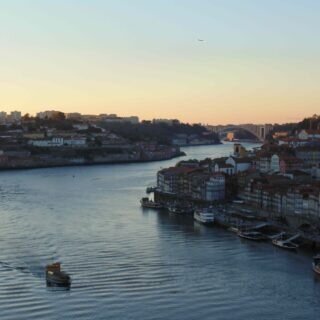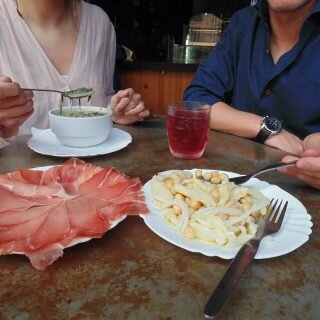While the Douro has been the lifeblood of Porto’s inception and still the river to which the city owes its existence, it can often be a rather difficult obstacle; it is deep, with tricky currents, and not particularly narrow either, with jagged and steep margins. Although the third longest in the peninsula, its discharge and drainage area are greater than both the Ebro’s and the Tagus. That makes the Douro quite a difficult obstacle to surmount, but one that must be so to connect Porto with its very important neighbour, Vila Nova de Gaia, let alone the rest of the country. Because of this, Porto is a city with a rather large amount of bridges, beautiful ones at that, bridges which define the city and the aesthetic.
The first of these is the only one out of commission: it is the Maria Pia Bridge. Inaugurated in 1877 it was designed by none other than Gustave Eiffel. It was built as a railway bridge to connect the Northern Line (Porto-Lisbon). Its wrought iron structure is remarkable and, had the largest span of any bridge of its time. The bridge however was becoming weak, the single track, the 20 kilometre per hour speed restriction, and the weight restrictions, all made it so that a replacement was in order. It was thus decommissioned in 1991.

The second is Luiz I Bridge, which came about 9 years later was built by Théophile Seyrig who was actually Eiffel’s business partner and mentee. They both submitted a project, but it was Seyrig who won, leaving Eiffel fairly miffed. Nevertheless, this bridge was extremely impactful in the life and urban design of Porto and Vila Nova de Gaia; before it was built, to cross on over the Douro in the two cities, one would need to go down to the Ribeira (the riverside) and cross the “Pensile Bridge” (the pillars of which are still present next to the bridge on the Porto side). But with the new 1886 bridge, now one could could cross from top to top. Large avenues formed on both sides as a result.


The third bridge is the westernmost of the six. This is the Arrábida Bridge, inaugurated in 1963, featuring the widest reinforced concrete arch of its time. It is part of the country’s first motorway, the A1 which connects Lisbon and the city of Porto.


The fourth bridge is the 1991 replacement to the previous railway bridge: São João bridge. It was inaugurated on Saint John’s on the 24th of June, beginning operations in 1994. This time, the bridge had pillars set on the water, which was unprecedented in Porto’s bridges due to the strong current and gravel riverbed. Nonetheless, the new bridge can handle the speeds, weights and volume of traffic, being stronger, electrified and double-track.

The fifth bridge is the easternmost one, which is also a motorway bridge with four lanes in each direction, was inaugurated in 1995, and was built to try and lighten the congestion in the western ends of the motorways, thus completing the other end of the ringways around Porto and Gaia.
The sixth bridge is east of the Luiz I bridge, and it was inaugurated in 2003 with the intention of replacing the local traffic which was subsequently restricted from the top shelf of the older bridge, to make way for Porto Metro’s yellow D Line (today the most travelled line). It was named after Infante Dom Henrique, who was a brilliant naval scientist who propelled Portugal’s discovery era.
All these bridges mark Porto deeply, contributing to its incredible aesthetic and dual relation with the Douro river. At the same time dear and necessary to the city, it is also something our bridges very elegantly hop across. As to the future? More bridges! A seventh bridge on the lower levels has already been announced for local motor traffic (so as to free Luiz I from it, much like with the Infante bridge). It will be called D. António Francisco dos Santos (old bishop of Porto). There are even plans for an eighth bridge for the metro, but I suspect that will be a long while from now. A lot to look forward to nonetheless!
You can see these amazing structures in any of our tours! Reach out!



